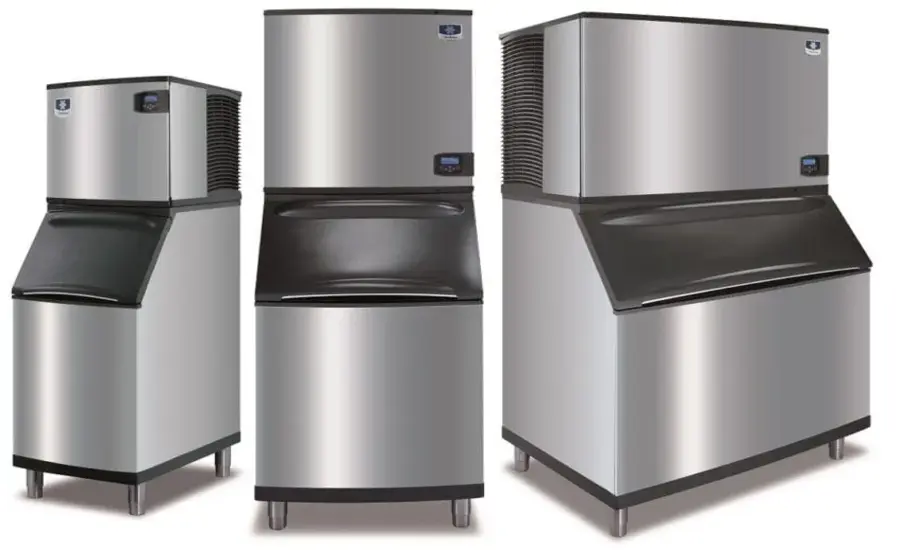When it comes to running a successful food service or hospitality business, having the right equipment is essential. For many businesses, a commercial ice maker is one of the most crucial pieces of equipment. Whether you own a restaurant, bar, hotel, or café, the ability to serve high-quality, fresh ice on demand can make a difference in customer satisfaction and operational efficiency. However, choosing the best commercial ice maker isn’t always straightforward due to the variety of types, sizes, and features available.
This guide will walk you through the essentials of selecting the ideal small commercial ice makers for your business. We’ll discuss different types of ice makers, their capacities, the types of ice they produce, and considerations for finding the right model for your specific needs.
Why a Commercial Ice Maker is Essential for Your Business
Commercial ice makers are designed to produce large quantities of ice quickly, which is critical for businesses in the food and beverage industry. Unlike residential ice makers, commercial units are built to withstand frequent usage and can keep up with the high demands of a busy environment. They help ensure you have ice available at all times, allowing you to serve chilled beverages, keep food items fresh, and meet the needs of your customers with ease.
A high-quality commercial ice maker provides consistent ice production, saving you from last-minute ice purchases, while also reducing waste. From enhancing drink presentation to preserving perishable items, an ice maker is a crucial investment for long-term profitability.
Types of Commercial Ice Makers
Choosing the right ice maker involves understanding the different types of machines available. Here are the primary categories to consider:
1. Modular Ice Makers
- Overview: Modular ice makers are designed to produce large volumes of ice, making them ideal for high-demand settings. These machines consist of two parts: the ice machine itself and a separate storage bin.
- Pros: Higher production capacity, flexibility in pairing with different storage bins.
- Best For: Restaurants, hotels, and bars with high ice needs.
- Considerations: Ensure you have adequate space for both the machine and the bin. Also, modular machines typically require more cleaning and maintenance.
2. Under-Counter Ice Makers
- Overview: Compact and space-saving, under-counter ice makers fit conveniently beneath countertops and have a built-in storage bin. They produce a moderate amount of ice and are generally quieter than modular models.
- Pros: Saves space, suitable for small businesses or locations with limited room, quieter operation.
- Best For: Smaller cafes, bars, and offices with moderate ice demand.
- Considerations: Since these models produce less ice, they may not be ideal for high-volume operations. It’s also essential to account for ventilation, as under-counter models require good airflow.
3. Countertop Ice Makers
- Overview: Countertop ice makers are small, portable units that produce nugget or bullet ice. They’re compact and fit easily on counters, offering quick ice production in smaller amounts.
- Pros: Compact, portable, affordable.
- Best For: Small office spaces, waiting areas, or businesses with minimal ice needs.
- Considerations: These machines generally have limited ice production and storage capabilities, so they’re not suited for high-demand environments.
4. Self-Contained Ice Makers
- Overview: Self-contained units combine the ice machine and storage bin into one compact unit, making them easy to install and maintain.
- Pros: All-in-one design, relatively easy to install and maintain, moderate ice production.
- Best For: Medium-sized restaurants, bars, and healthcare facilities.
- Considerations: These units require dedicated floor or countertop space and typically produce less ice than modular machines.
Types of Ice Produced by Commercial Ice Makers
Different ice types serve different purposes, and understanding these can help you choose the right commercial ice maker for your specific needs.
1. Crescent Ice
- Appearance: Crescent-shaped, with a smooth, curved edge.
- Benefits: Melts slower, minimizing drink dilution, and stacks efficiently in storage bins.
- Ideal For: Cocktails, mixed drinks, and soft drinks in restaurants and bars.
2. Cube Ice
- Appearance: Available as full-size cubes, half cubes, or dice.
- Benefits: Slow-melting and versatile; can be used in a wide range of drinks and for food preservation.
- Ideal For: Restaurants, bars, and cafés needing versatile ice options.
3. Nugget Ice
- Appearance: Soft, chewable, small ice pellets.
- Benefits: Absorbs flavors well, making it perfect for smoothies and specialty drinks.
- Ideal For: Smoothie shops, health care facilities, and specialty cafés.
4. Flake Ice
- Appearance: Small, thin pieces that are soft and easy to mold.
- Benefits: Great for food displays, particularly in seafood or salad bars, as well as cooling beverages.
- Ideal For: Grocery stores, seafood markets, and salad bars.
5. Gourmet Ice
- Appearance: Crystal-clear, usually in unique shapes (e.g., octagon or sphere).
- Benefits: Enhances drink aesthetics and melts slowly.
- Ideal For: Upscale bars, lounges, and fine dining establishments where presentation is a priority.
Key Factors to Consider When Choosing a Commercial Ice Maker
Now that we’ve covered the basics, let’s dive into some practical factors you’ll need to consider to make an informed decision.
1. Ice Production Volume
- Evaluate Your Needs: The right ice maker for you will depend on your business’s peak ice demand. Consider how much ice you use on an average day and during busy periods.
- Daily Production Rate: Commercial ice makers are rated by the amount of ice they produce in 24 hours. For small to medium-sized businesses, a machine with a daily output of 150-300 pounds of ice should suffice. Larger establishments may require 400 pounds or more.
2. Space Constraints
- Measure Carefully: Before purchasing, measure the space where you plan to install the ice maker. Make sure to account for clearance, especially for machines that require ventilation.
- Consider Ventilation Needs: Some ice makers need adequate ventilation to operate efficiently, especially air-cooled models. Water-cooled models may be a better option for tightly enclosed spaces.
3. Water Source and Drainage Requirements
- Access to Water: Ensure you have access to a reliable water source near the installation location. Consider if the water quality requires a filter to prevent mineral buildup.
- Drainage Needs: Most commercial ice makers need a drainage system to dispose of melted ice. Choose a model that aligns with your facility’s drainage capabilities (e.g., gravity drain or pump drain).
4. Energy Efficiency
- Look for Energy Star Certification: Energy-efficient models help lower utility costs and are environmentally friendly. Check for units with an Energy Star rating, which consume less power while maintaining high production.
- Consider Long-Term Costs: While energy-efficient models may have a higher upfront cost, they save money in the long run by reducing power and water consumption.
5. Maintenance and Cleaning
- Ease of Cleaning: Regular cleaning is essential to ensure safe and high-quality ice. Some machines have self-cleaning functions, which can simplify maintenance.
- Water Filters: Install a water filter to prevent mineral buildup, reduce contaminants, and extend the machine’s lifespan.
Popular Small Commercial Ice Maker Brands and Models
To help you get started, here’s a brief overview of some reliable brands and models widely recommended for their quality and durability.
1. Scotsman
- Model: Scotsman CU50GA-1A
- Features: Energy-efficient, compact under-counter unit, ideal for smaller bars and cafés.
- Ice Type: Gourmet ice.
- Best For: Small to medium businesses seeking premium ice quality.
2. Hoshizaki
- Model: Hoshizaki KM-201BAJ
- Features: High production rate, air-cooled under-counter unit, and known for reliability.
- Ice Type: Crescent ice.
- Best For: Busy bars, restaurants, and high-volume settings.
3. Manitowoc
- Model: Manitowoc UYF-0140A
- Features: Compact, under-counter unit, energy-efficient with easy-to-clean components.
- Ice Type: Half cube ice.
- Best For: Restaurants and cafes needing moderate ice capacity.
4. Ice-O-Matic
- Model: Ice-O-Matic GEMU090
- Features: Compact and quiet, countertop unit producing chewable nugget ice.
- Ice Type: Nugget ice.
- Best For: Smoothie shops, healthcare settings, and specialty beverage services.
Tips for Maintaining Your Commercial Ice Maker
To maximize the life of your ice maker and maintain the quality of ice, regular maintenance is essential.
- Regular Cleaning: Clean the interior, ice bin, and removable parts every 1-2 weeks. Follow the manufacturer’s cleaning instructions to prevent bacterial buildup.
- Check Water Filters: Replace water filters every 6 months to prevent mineral buildup and ensure optimal water quality.
- Inspect and Service: Have your machine serviced by a professional at least once a year. Routine inspections help detect potential issues before they escalate.
- Monitor the Temperature: Keep the area around the ice maker well-ventilated and maintain a consistent room temperature, as extreme temperatures can affect ice production.
Final Thoughts: Which Commercial Ice Maker is Right for You?
Choosing the right ice makers commercial depends on your business’s unique needs, space availability, and budget. By understanding the different types of ice makers, ice shapes, and production capacities, you can select the best machine to ensure reliable ice supply and enhance customer satisfaction.
Whether you’re a café looking for a small under-counter unit or a busy bar requiring a high-capacity modular ice maker, investing in the right machine will pay off in convenience, quality, and efficiency. Prioritize maintenance to ensure long-lasting performance, and your ice maker will be a valuable asset for years to come










